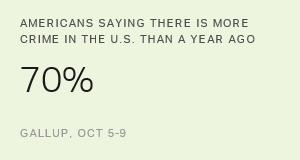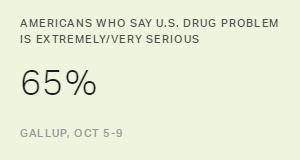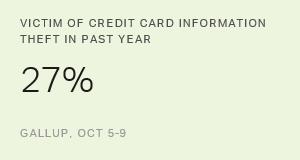Story Highlights
- Perceptions of nationwide crime unchanged from 2015
- Perceptions of local crime also steady
- 60% of Americans believe crime problem in U.S. extremely or very serious
WASHINGTON, D.C. -- Seven in 10 Americans say there is more crime in the U.S. than a year ago, unchanged from 2015. Two in 10 believe there is less crime. The percentage who believe crime is up from a year ago is near the recent high of 74% in 2009, but still significantly below the record high of 89% in 1992.
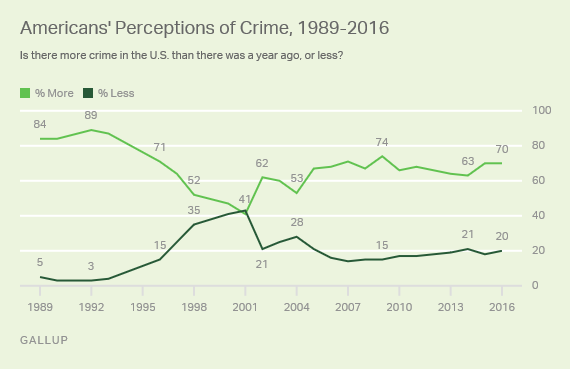
Since Gallup began asking this question in 1989, a majority of Americans have usually said there is more crime than there was the year before. A notable exception was in October 2001, soon after the Sept. 11 attacks, when 41% expressed this sentiment. By the next year, perceptions of there being more crime in the U.S. than in the prior year returned to the majority level, possibly because of the 2002 D.C. sniper shootings, and have since remained there.
The FBI announced in September of this year that homicides were up by 11% in 2015 from the previous year. The violent crime rate also increased, by about 4%, in 2015 and was the highest in three years. Gallup measured a seven-percentage-point increase from 2014 to 2015 in perceptions that there was more crime in the U.S. than the prior year, but found no change this year. Government data on crime rates for 2016 won't be released until next year, so it is unclear whether Americans' perceptions about crime in the U.S. are consistent with the actual crime trend.
Perceptions of Local Crime Steady From Last Year
In line with this year's stability in Americans' beliefs about U.S. crime, Americans' perceptions of crime in the area where they live were unchanged from 2015. Forty-five percent now say there is more crime locally than last year, essentially unchanged from 46% a year ago. Thirty-three percent now say there is less local crime and 20% say there is the same amount.
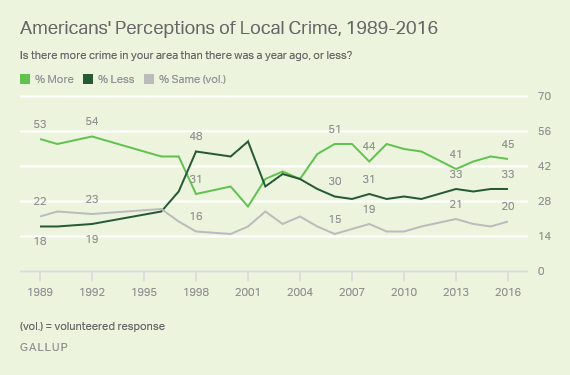
As noted, Americans' perceptions of crime locally and nationally are unchanged this year, even as violent crime is reportedly up from the previous year in certain major cities such as Chicago and Los Angeles. Donald Trump made the perception that violent crime is rising in the U.S. a hallmark of his campaign, especially in his acceptance speech at the Republican National Convention in July. In reply, President Barack Obama said murder and violent crime rates are much lower today than when Ronald Reagan was president. Gallup's trend underscores this long-term decline. A majority of Americans from 1989 to 1992 thought local crime was increasing, almost 10 percentage points higher than today.
Perceived Seriousness of U.S. Crime Problem Remains High
Along with the stability in Americans' perceptions of the national and local crime rate, Americans' views of the seriousness of the national crime problem are unchanged. Amid the noise of the presidential election year, with Trump frequently citing crime as a chief concern in the U.S., 60% of Americans say the problem of crime in the nation is "extremely" or "very" serious. This is essentially unchanged from October 2015 but tied for the high point over the past 16 years.
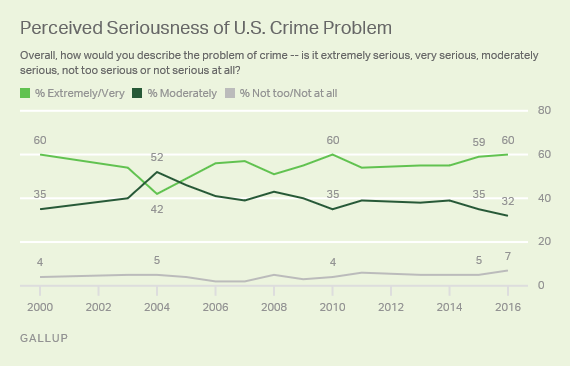
While in most years, the majority of Americans have said the crime problem was "extremely" or "very serious," that has not been the case in all years. In 2004, perceptions of the seriousness of crime dropped, with 42% saying the crime problem was extremely or very serious -- and more saying it was moderately serious or not serious.
Bottom Line
Americans have long believed that crime is on the rise in the U.S., even in years when it was sharply in decline. Media reports about high-profile crimes might create the perception that crime is on the rise, even if changes in actual crime rates have not always supported that idea.
Recent reports indicate crime was up in 2015. Americans may have detected this uptick last year -- before official crime statistics were released -- when the percentage saying there was more crime than a year earlier increased. The U.S. government will release crime statistics for 2016 next year, which will validate whether Americans' perceptions about crime -- which held steady this year -- are correct.
Historical data are available in Gallup Analytics.
Survey Methods
Results for this Gallup poll are based on telephone interviews conducted Oct. 5-9, 2016, with a random sample of 1,017 adults, aged 18 and older, living in all 50 U.S. states and the District of Columbia. For results based on the total sample of national adults, the margin of sampling error is ±4 percentage points at the 95% confidence level. All reported margins of sampling error include computed design effects for weighting.
Each sample of national adults includes a minimum quota of 60% cellphone respondents and 40% landline respondents, with additional minimum quotas by time zone within region. Landline and cellular telephone numbers are selected using random-digit-dial methods.
View survey methodology, complete question responses and trends.
Learn more about how the Gallup Poll Social Series works.
